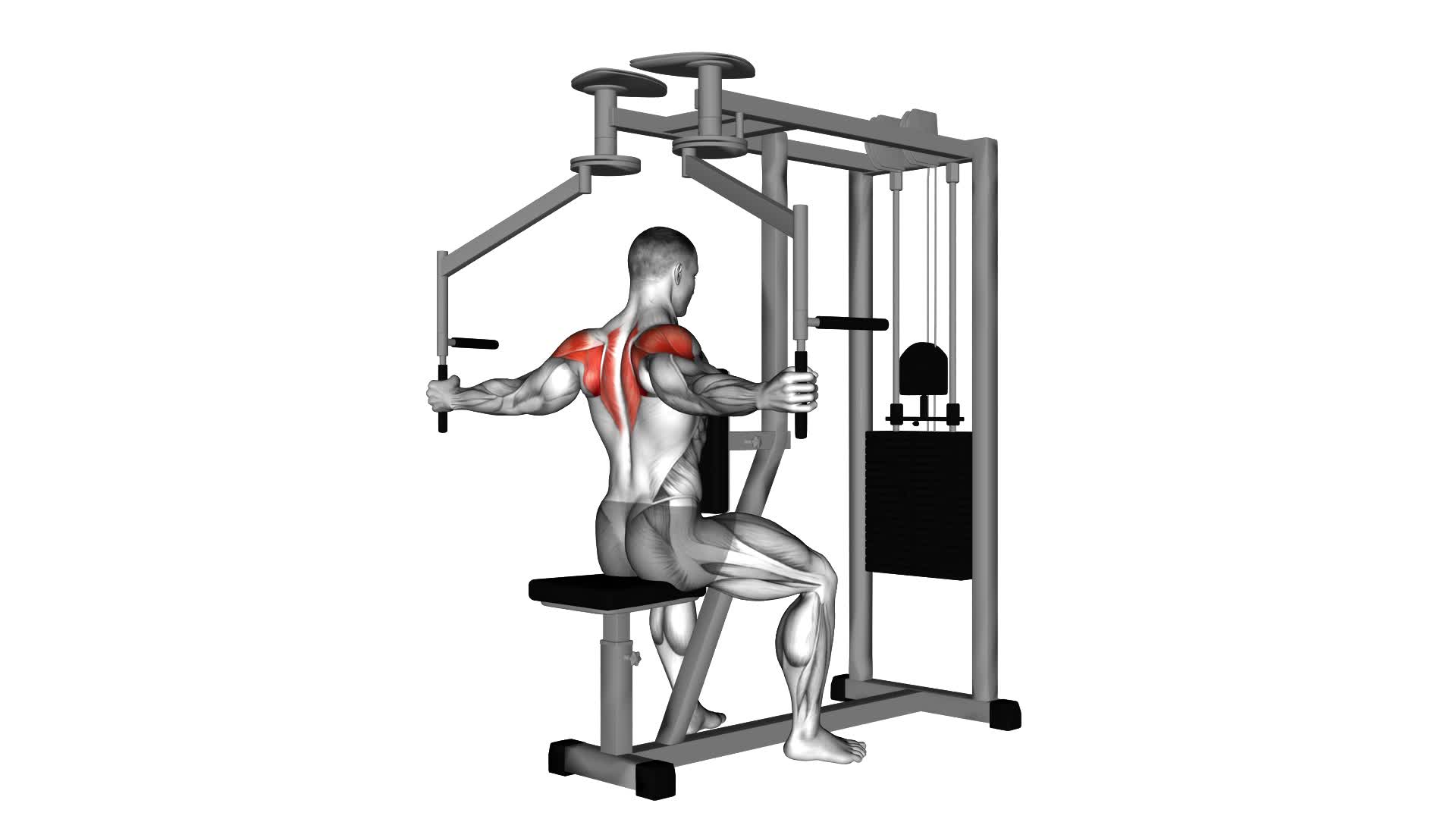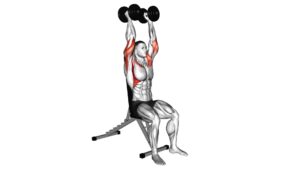Lever Seated Reverse Fly (Parallel Grip) – Video Exercise Guide & Tips

Are you looking for an effective exercise to target your back muscles? Look no further than the Lever Seated Reverse Fly (Parallel Grip).
Watch This Exercise Video
This video exercise guide will show you the proper form and technique to maximize your results. With variations and modifications available, you can customize this exercise to fit your fitness level.
Get ready to strengthen and tone your back with this challenging yet rewarding workout. Let's get started!
Key Takeaways
- Targets upper back muscles (rhomboids and rear deltoids)
- Improves posture and reduces risk of injury
- Enhances upper body strength and stability
- Allows for variations in grip positions
Benefits of Lever Seated Reverse Fly (Parallel Grip)
To maximize the effectiveness of your workout, it's important to understand the benefits that the Lever Seated Reverse Fly (Parallel Grip) exercise can provide. This exercise primarily targets the muscles of your upper back, specifically the rhomboids and rear deltoids. By performing this exercise, you can improve your posture and strengthen the muscles that support your shoulder blades, reducing the risk of injury. Additionally, the Lever Seated Reverse Fly (Parallel Grip) exercise helps to improve your overall upper body strength and stability.
One of the key benefits of this exercise is that it allows for variations in grip positions. By using a parallel grip, with your palms facing each other, you can target different areas of your back. This variation helps to engage the muscles in a unique way, providing a more well-rounded workout for your upper back and shoulders. You can also adjust the weight and resistance to suit your fitness level and goals, making this exercise suitable for beginners and advanced trainers alike.
Equipment and Setup for Lever Seated Reverse Fly
To properly set up and perform the Lever Seated Reverse Fly (Parallel Grip) exercise, you'll need a lever seated reverse fly machine and a bench. Here is a step-by-step guide to the equipment and setup for this exercise:
- Position the lever seated reverse fly machine:
- Adjust the seat height so that your feet are flat on the floor and your knees are at a 90-degree angle.
- Sit with your back against the backrest and grasp the handles with an overhand grip.
- Adjust the weight:
- Use the weight stack to select an appropriate resistance level for your fitness level and goals.
- Start with a lighter weight and gradually increase as you become more comfortable with the exercise.
- Set up the bench:
- Place a bench in front of the machine.
- Make sure it's stable and at a height that allows you to comfortably reach the handles.
- Sit on the bench facing the machine.
- Begin the exercise:
- With a controlled motion, squeeze your shoulder blades together and pull the handles towards your chest.
- Keep your elbows slightly bent throughout the movement.
- Pause at the top of the movement and then slowly return to the starting position.
Proper Form and Technique for Lever Seated Reverse Fly
Now let's focus on perfecting your form and technique for the Lever Seated Reverse Fly (Parallel Grip) exercise, ensuring you get the most out of each repetition.
To perform this exercise correctly, start by sitting upright on the lever machine with your feet flat on the floor. Grasp the handles with a parallel grip, keeping your palms facing each other. Engage your core and maintain a straight back throughout the movement.
As you exhale, slowly squeeze your shoulder blades together and pull the handles backward. Keep your elbows slightly bent and maintain control as you bring the handles back to the starting position. It's important to avoid using momentum or swinging your body during this exercise. Focus on using your back muscles to initiate and control the movement.
Common mistakes to watch out for include rounding your shoulders forward, shrugging your shoulders, or using your arms to perform the movement instead of your back muscles.
Variations and Modifications for Lever Seated Reverse Fly
To modify the Lever Seated Reverse Fly exercise, you can adjust the grip, resistance level, or incorporate unilateral movements. Here are some variations and modifications you can try:
- Grip Variations: Instead of using a parallel grip, you can switch to an overhand grip or an underhand grip. This will target different muscles in your back and shoulders, providing a new challenge and variation to your workout.
- Resistance Level: If you find the exercise too easy, you can increase the resistance by using heavier weights or resistance bands. On the other hand, if it's too challenging, you can decrease the resistance by using lighter weights or reducing the tension in the bands.
- Unilateral Movements: Instead of performing the exercise with both arms at the same time, you can try doing it one arm at a time. This will engage your stabilizer muscles and improve your balance and coordination.
- Range of Motion: You can also modify the exercise by adjusting the range of motion. You can start with a smaller range and gradually increase it as you get stronger and more comfortable with the movement.
By incorporating these variations and modifications, you can keep your workouts interesting and continue challenging your muscles in different ways.
Now, let's move on to some tips for getting the most out of the lever seated reverse fly exercise.
Tips for Getting the Most Out of Lever Seated Reverse Fly
To maximize your results with the Lever Seated Reverse Fly exercise, focus on proper form and technique. Paying attention to these aspects will help you avoid common mistakes and ensure optimal muscle activation.
One common mistake to avoid is using too much weight. It's important to start with a weight that allows you to maintain proper form throughout the exercise. Using excessive weight can lead to swinging or jerking motions, which can put unnecessary strain on your muscles and increase the risk of injury.
Another mistake is neglecting the mind-muscle connection. To effectively activate your muscles, focus on squeezing your shoulder blades together as you perform the movement. This will ensure that you're targeting the correct muscles and maximizing their activation.
Additionally, maintaining a neutral spine is crucial for proper form. Avoid rounding your back or arching it excessively during the exercise. Instead, keep your spine in a neutral position and engage your core muscles to stabilize your body.
Finally, remember to control the movement throughout the exercise. Avoid using momentum or relying on the weight to carry you through the motion. Instead, focus on a slow and controlled movement, emphasizing the contraction of your shoulder blades.
Frequently Asked Questions
How Many Sets and Reps Should I Do for Lever Seated Reverse Fly (Parallel Grip)?
For optimal weight and progression, start with a weight that challenges you but still allows for proper form. Gradually increase the weight as you get stronger.
As for sets and reps, aim for 3-4 sets of 8-12 reps. This will help build both strength and muscle endurance.
When performing lever seated reverse fly (parallel grip), common mistakes to avoid include using excessive momentum, rounding your back, and not fully squeezing your shoulder blades together at the top of the movement.
Can I Perform Lever Seated Reverse Fly (Parallel Grip) With Dumbbells Instead of a Lever Machine?
You can definitely perform the lever seated reverse fly (parallel grip) with dumbbells instead of a lever machine. There are pros and cons to using both methods.
With dumbbells, you have more freedom of movement and can engage more stabilizer muscles. However, using a lever machine provides more stability and allows for easier progression in weight.
To perform the exercise with dumbbells, sit upright, hold the dumbbells with a parallel grip, and raise them out to your sides while maintaining a slight bend in your elbows.
Is Lever Seated Reverse Fly (Parallel Grip) Suitable for Beginners or Is It More Advanced?
For beginners, the lever seated reverse fly (parallel grip) may be more advanced.
However, there are progression options to make it suitable for all fitness levels.
Start with lighter weights and focus on proper form and technique before increasing the weight.
Common mistakes to avoid include using too much momentum, hunching the shoulders, and not engaging the back muscles fully.
Take it slow and gradually increase the intensity to avoid injury and maximize results.
What Muscles Does Lever Seated Reverse Fly (Parallel Grip) Primarily Target?
The lever seated reverse fly (parallel grip) primarily targets your rear deltoids, which are the muscles located on the back of your shoulders. By incorporating this exercise into your workout routine, you can strengthen and tone these muscles, improving your posture and overall upper body strength.
Additionally, the lever seated reverse fly engages your upper back and traps, helping to improve your posture and reduce the risk of shoulder injuries.
Can I Incorporate Lever Seated Reverse Fly (Parallel Grip) Into a Full-Body Workout Routine or Is It Better to Focus on Specific Muscle Groups?
You can definitely incorporate lever seated reverse fly (parallel grip) into your full-body workout routine! This exercise targets multiple muscle groups, including your rear delts, upper back, and traps.
By incorporating compound exercises like this, you can work multiple muscle groups at once, saving time and increasing overall strength and muscle development.
Conclusion
In conclusion, the lever seated reverse fly (parallel grip) is a highly effective exercise for targeting the muscles in the back and shoulders. It can help improve posture, strengthen the upper body, and enhance overall muscle balance.
By following proper form and technique, using the right equipment and setup, and incorporating variations and modifications, you can maximize the benefits of this exercise.
Remember to focus on maintaining good posture and engaging the targeted muscles throughout the movement for optimal results.

Author
Years ago, the spark of my life’s passion ignited in my mind the moment I stepped into the local gym for the first time. The inaugural bead of perspiration, the initial endeavor, the very first surge of endorphins, and a sense of pride that washed over me post-workout marked the beginning of my deep-seated interest in strength sports, fitness, and sports nutrition. This very curiosity blossomed rapidly into a profound fascination, propelling me to earn a Master’s degree in Physical Education from the Academy of Physical Education in Krakow, followed by a Sports Manager diploma from the Jagiellonian University. My journey of growth led me to gain more specialized qualifications, such as being a certified personal trainer with a focus on sports dietetics, a lifeguard, and an instructor for wellness and corrective gymnastics. Theoretical knowledge paired seamlessly with practical experience, reinforcing my belief that the transformation of individuals under my guidance was also a reflection of my personal growth. This belief holds true even today. Each day, I strive to push the boundaries and explore new realms. These realms gently elevate me to greater heights. The unique combination of passion for my field and the continuous quest for growth fuels my drive to break new ground.







